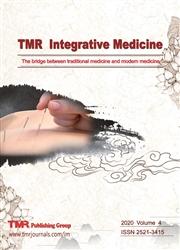Integrated network pharmacology analysis and in vitro cell experiments to reveal the mechanisms of Ligusticum chuanxiong Hort. in the treatment of non-alcoholic fatty liver disease
引用次数: 0
Abstract
Background: Non-alcoholic fatty liver disease (NAFLD) is a liver disease of unknown etiology. A traditional Chinese medicine Ligusticum chuanxiong Hort. (CX), it has been used about 2,000 years. Until now, the mechanism of action of CX on NAFLD remains unclear. Method: We first tested the toxicity of CX to AML12 cells with CCK-8. In vitro cell models of NAFLD were made using free fatty acid, and used Oil Red O staining tested lipid droplets. Then the active compounds of CX were collected from TCMSP and literatures, and SwissTargetPrediction, Search Tool for Interacting Chemicals, Encyclopedia of Traditional Chinese Medicin, Bioinformatics Analysis Tool for Molecular mechANism of Traditional Chinese Medicine database were used to predict the targets of the compounds. DRUGBANK, Online Mendelian Inheritance in Man, Therapeutic Target Database, DisGeNET and GeneCards database were used to predict the targets of NAFLD. Use Venn diagram to obtained the intersection targets by, and analyzed the protein-protein intersection network. Use Kyoto Encyclopedia of Genes and Genomes and Gene Ontology to forecast the function of intersection genes. Molecular docking was used to evaluate the interaction between hub gene and active ingredients. Finally, use western blotting to determine the effects of CX on PPARA, PPARG, IL1B and TNF proteins. Result: CX can reduce the production of AML12 cell lipid droplets. A total of 15 chemical components were identified from CX. Folic acid, chrysophanol and sitosterol were the main components of CX against NAFLD. ALB, TNF, PPARG and PPARA proteins were the main targets of CX in the treatment of NAFLD. PPAR signaling pathway and fatty acid degradation were closely related to anti-NAFLD. Molecular docking results shows that folic acid was the main active ingredient of CX for NAFLD treatment, and TNF is the main potential target. The cellular NAFLD model showed that CX up-regulated the expression of PPARA and PPARG protein and down-regulated inflammatory factor IL-1B and TNF expression. Conclusion: Our study suggests that CX has a therapeutic effect on NAFLDA, which may be related to the PPAR pathway and the reduction of inflammatory cytokines.结合网络药理分析和体外细胞实验揭示川芎的作用机制。用于治疗非酒精性脂肪肝
背景:非酒精性脂肪性肝病(NAFLD)是一种病因不明的肝病。中药川芎。(CX),它已经使用了大约2000年。迄今为止,CX对NAFLD的作用机制尚不清楚。方法:先用CCK-8检测CX对AML12细胞的毒性。采用游离脂肪酸制备NAFLD体外细胞模型,油红O染色检测脂滴。然后从TCMSP和文献中收集CX的活性化合物,并利用SwissTargetPrediction、相互作用化学物质搜索工具、中药百科全书、中药分子机制生物信息学分析工具数据库对化合物的靶点进行预测。利用DRUGBANK、在线孟德尔遗传、治疗靶点数据库、DisGeNET和GeneCards数据库预测NAFLD的靶点。利用维恩图得到交叉目标,并对蛋白质-蛋白质交叉网络进行了分析。利用京都基因与基因组百科全书和基因本体对交叉基因的功能进行预测。采用分子对接的方法评价枢纽基因与活性成分之间的相互作用。最后,采用western blotting检测CX对PPARA、PPARG、IL1B和TNF蛋白的影响。结果:CX能减少AML12细胞脂滴的产生。从CX中鉴定出15种化学成分。叶酸、大黄酚和谷甾醇是CX抗NAFLD的主要成分。ALB、TNF、PPARG和PPARA蛋白是CX治疗NAFLD的主要靶点。PPAR信号通路和脂肪酸降解与抗nafld密切相关。分子对接结果显示,叶酸是CX治疗NAFLD的主要有效成分,TNF是主要潜在靶点。细胞NAFLD模型显示,CX上调PPARA和PPARG蛋白表达,下调炎症因子IL-1B和TNF表达。结论:本研究提示CX对NAFLDA具有治疗作用,其作用机制可能与PPAR通路及炎性细胞因子的减少有关。
本文章由计算机程序翻译,如有差异,请以英文原文为准。
求助全文
约1分钟内获得全文
求助全文

 求助内容:
求助内容: 应助结果提醒方式:
应助结果提醒方式:


